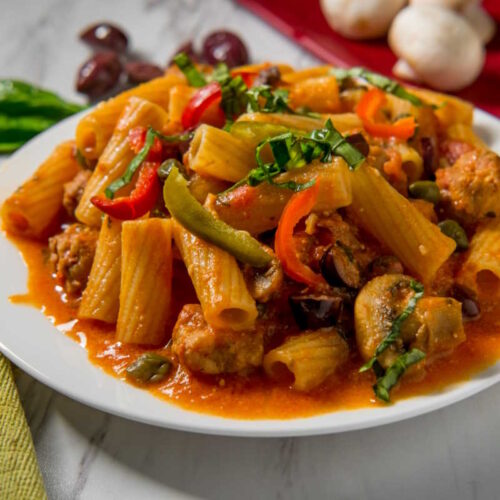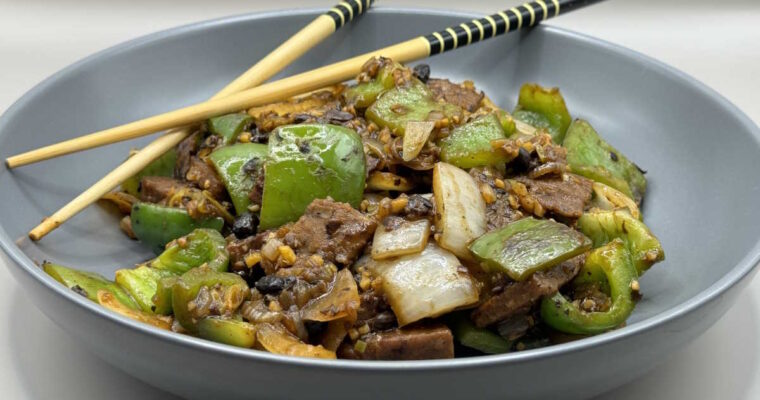This simple green pepper and vegan sausage pasta recipe is a timeless Italian American dish, with thick cut sausage and a chunky pepper and tomato sauce it’s a hearty dish that packs some big flavour.
If you use a can of crushed tomatoes and pre-minced garlic, then you aren’t going to need to do much more than chop an onion and a couple of peppers, and the stove will do the rest of the work for you. Pick your favourite plant-based sausage to be the protein-packed main ingredient for this intercontinental classic.
We’d recommend that you don’t use a link sausage or a chipolata, go for a thicker option so that you can slice them up at a 45° angle, and you’ll get some extra style points for some thick-cut protein pieces.
Finally, your onion choice matters greatly in Italian dishes, and which type you use will transform your sauce. Typically, in a spaghetti sauce, and this dish as well, yellow onion is used and it becomes quite sweet once it’s cooked. We often use red onions in Italian home cooking though as we prefer a sharper taste and the colour they bring to the plate.
Green Pepper and Vegan Sausage Pasta Ingredients
225 g rigatoni
225 g plant-based sausages
1 yellow onion
2 green bell peppers
1 tsp minced garlic
50 g tomato puree
2/3 can crushed tomatoes
Olive oil
Ground rock salt and peppercorns (season to taste)
30 g vegan Parmesan Cheese (optional)
Fresh basil to serve (optional)
Green Pepper and Vegan Sausage Pasta Recipe
Let’s start with the little food prep that’s needed for this meal. Deseed both green peppers, and dice them up into squares, but not too small. We would like to have a chunky texture to most of the ingredients in this dish, so if you cut each pepper piece so that it’s close to 2 cm in size we will be off to a good start. Then go ahead and do the same with the onion, dice it up into pieces of a reasonable size. Before we do any cooking, you should also bring 1.75 l of water to a boil in a medium saucepan, just so we’re ready to cook the pasta as soon as the sausages are about done.
Next up, you should cook your chosen plant-based sausage. Most of those, that we have bought, are best cooked by frying them in a little oil over medium heat for no more than 10 minutes. We would use olive oil for this dish and heat your frying pan before adding the oil, and then the sausages straight after. Turn them frequently to ensure they cook evenly, and once they’re done, transfer them out of the frying pan and set them aside to cool enough until you can handle them. You should slice your sausages at a 45° angle and close to 1.5 cm thick when you can. Also, no need to wash up the frying pan, we will use it to cook up some veggies soon.
Add the rigatoni pasta to the now boiling water and let it bubble away until it’s al-dente. Look to the guide on the back of your pasta packaging for a guide to how long this should be. You just might have to do a little math to account for the amount you’re using, but if you went with just over 10 minutes, you would be close. Once cooked, drain away nearly all the water, except for 125 ml. Keep this in reserve for the sauce. Set the pasta aside for now.
To keep the overall cook time down, you can pan-fry all the vegetables while boiling the pasta. Using the same pan that you cooked the sausages in, warm up the pan to medium-high heat once more, and then add a small amount of olive oil followed by the diced green peppers and onion. Cook this vegetable medley until the onion and peppers just start to soften, then add the minced garlic and keep stir-frying everything for another minute before squeezing in the tomato puree, giving all your ingredients a good mixing before allowing everything to fry for at least another minute.
To bring everything together, pour 2/3 of a can of crushed tomatoes, and the sliced sausage we fried up already, and the pasta. Turn the heat down so that the sauce is just bubbling and allow everything to simmer for 5 minutes, stirring occasionally. Once the pasta and vegetables have taken on some of the tomato water, and the sauce has started to thicken up, then you can season to your tastes with a few cracks of salt and pepper. If you overshoot here and the sauce starts to dry up, this is where you can add a splash of the pasta water we kept back before draining. Finally, toss in half of the vegan Parmesan cheese and give it a good stir before tasting your Italian creation one last time before serving it up. Once plated, garnish with the remaining parm and a few fresh basil leaves.

GREEN PEPPER AND VEGAN SAUSAGE PASTA
Ingredients
- 225 g Rigatoni
- 225 g plant-based sausages
- 1 yellow onion
- 2 green bell peppers
- 1 teaspoon of minced garlic
- 50 g tomato puree
- 2/3 can of crushed tomatoes
- Olive oil
- Rock salt and peppercorns season to taste
- 30 g of vegan parmesan cheese optional
- Fresh basil to serve optional
Instructions
- Deseed the two green bell peppers and dice them into 2 cm squares
- Peel and dice the yellow onion
- Boil 1.75 l of water in a saucepan
- Cook the 225 g of plant-based sausages according to the packaging and then set them aside to cool
- Once cooled cut them at a 45° angle into thick slices
- Add the pasta to the boiling water and cook it al-dente according to the packaging
- Once cooked drain, set aside and keep 125 ml of the pasta water for the sauce
- In the same pan as the sausages were fried in, reheated over medium-high heat, add a small amount of oil and then the diced pepper and onion
- Once the green peppers and onion have softened, add minced garlic and stir-fry everything for another minute
- Add the tomato puree and keep mixing and frying everything together for another minute
- Pour in the crushed tomatoes, sausage and pasta and turn down the heat until everything is just bubbling, stir occasionally and let this simmer for 5 minutes
- When the sauce starts to thicken, season with salt and pepper to your taste
- If the sauce starts to dry up add some of the saved pasta water
- Stir in half of the vegan Parmesan, then serve and garnish with the remaining vegan cheese

Recipe FAQs
What’s the difference between green and red peppers?
Green Peppers:
- Immature Bell Peppers: Green bell peppers are harvested when they are still immature and have not fully ripened.
- Crisp and Slightly Bitter: They have a crisp texture and a slightly bitter or grassy flavor. Some people describe green peppers as having a slightly tangy or peppery taste.
- Less Sweet: Green peppers are less sweet than their mature counterparts, which contributes to their slightly bitter profile.
- Earthy Undertones: There are often earthy undertones in the flavor, and they can sometimes taste mildly astringent.
Red Peppers:
- Fully Ripe Bell Peppers: Red bell peppers are green peppers that have been left to ripen fully on the plant. As they ripen, they turn from green to red.
- Sweet and Fruity: Red peppers have a sweeter, fruitier flavor compared to green peppers. The sweetness becomes more pronounced as they ripen.
- Richer and More Complex: Red peppers have a richer, more complex flavor profile with a touch of sweetness, making them popular for snacking and adding a sweet note to dishes.
- Ideal for Roasting: Their sweet flavor intensifies when roasted, and they are often used for making roasted pepper dishes, soups, and spreads.





